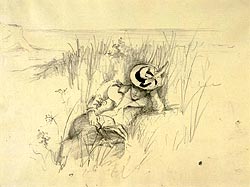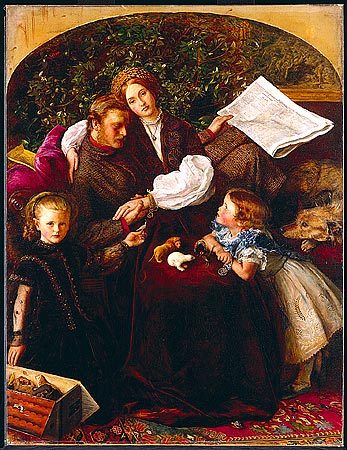
John Everett Millais
1856
Oil on canvas
The Putnam Dana McMillan Fund
|
Crimean War
Many British soldiers died of wounds or disease in the senseless Crimean War (1854-56), the result of long-standing political
and economic disputes between England, France, Turkey and Russia. Each of these countries wanted to control the prosperous trade in
the Middle East and to gain possession of territories in the region. Russia was defeated by the alliance of the other three countries,
and on March 18, 1856, after a long diplomatic struggle, a peace treaty was signed in Paris. Russia made significant military
concessions, but in the end no country achieved its aims.1
In the eyes of the English public, the Crimean War was also noted for large numbers of military officers who were able to avoid field duty
by pleading false domestic excuses. According to one interpretation of the story, Millais had originally intended to satirize these
shirkers in his picture, which would have been titled: "Urgent Private Affairs". But when peace broke out and public sentiment shifted,
he thought it prudent to alter the painting to make it convey a politically correct idea. Perhaps the composition would make more
sense, however, if Millais had clearly portrayed it as a satire, by making it unmistakable that the gentleman resting comfortably at
home was not a war invalid, and had never gone to the battle front. The viewer would have then interpreted him as a shirker who had
left the honorable but dangerous task of defending his country to less privileged men. In that case the puzzling fact that the man
shows no scars or bandages or any other evidence of illness would be satisfactorily explained. |

|
|
Young Woman Reading on the Dunes
Sir John Everett Millais
19th century
Pencil and wash
The Minneapolis Institute of Arts |
Pre-Raphaelite Brotherhood
Very early in his career, Millais was one of the founding members of the Pre-Raphaelite Brotherhood, a group of British painters
who opposed the sort of inflexible idealization of subjects and techniques endorsed by the powerful Royal Academy. Instead, their
work emphasized the close observation of nature, and the depiction of contemporary events. Using bright colors on a white background,
they were able to achieve convincing illusions of depth and brilliant, jewel-like qualities in colors. Peace Concluded is a strong
example of the Pre-Raphaelite style.
Victorian Ideals
Scholars do not agree about the subject of this painting, and Millais himself never stated it. Although real people certainly
posed for the composition, it is not the portrait of an actual family, but rather of a common family situation in contemporary England.
Therefore the subject cannot be properly classified as a myth or a legend. Whether it was originally his intention or not, the artist
has elevated this scene to the status of a heroic legend by skillfully incorporating symbolic details and implied conclusions. The
family is deemed heroic because its members exemplify many values Victorian England held dear: love of country, devotion to duty, the
sacrifices made by the family while the father was at war by first anxiously waiting at home and then coping with an invalid, fidelity
between husband and wife, and optimism for the future.

|
Roll over the image to see details from Peace Concluded |
Peace Concluded
Each member of the family tells us something about the meaning of the picture, by what they wear and by their actions.2 The
father wears a dressing gown, indicating that he is convalescing, possibly from a concealed wound. He has just read the news of the
war's end in the London Times newspaper, evidently with mixed emotions. Previously he had been reading a popular contemporary novel
by William Thackeray (now lying behind his pillow), The Newcomes, about an exceptionally virtuous military man.3 The dog is an Irish
wolfhound, an ancient British breed. Dogs usually symbolizes strength and fidelity to man, and also marital fidelity when portrayed
together with a married couple.
On his wife's face there is a resigned, melancholy gaze.4 Perhaps she is despondent about the gravity of her husband's condition. She wears
an embroidered velvet gown and heavy gold jewelry, indicating that the family is well off and can afford such luxuries.5
The little girl on the right wears a delicate lace dress, and clutches a medal bearing Queen Victoria's profile that her father had obviously
earned. This medal honored participants in any of the five major battles of the war. She has been playing with the toy animals on her
mother's lap, which represent the four warring countries: Britain (lion), Russia (bear), the Ottoman Empire (turkey) and France
(rooster). These animals belong to a toy Noah's Ark set, then commonly found in English households. (The rest of the animals are in
the box on the floor).
The other little girl holds a toy dove carrying an olive branch in its beak, symbolizing peace, but may also refer to the dove's role in the
biblical story of Noah, when it returns to the Ark with proof of land. This child, too, wears a richly decorated velvet dress. The
turkey carpet on the floor is another sign of the family's wealth and comfort.
Behind the group is a large, spreading myrtle bush. Since it is an evergreen, myrtle symbolizes eternal love, in particular conjugal
fidelity. The battle picture on the wall represents an engraving, by James Heath, of a renowned painting by John Singleton Copley,
the Death of Major Pearson. As a young commander, Major Pierson led his troops to victory by repelling a French invasion, but lost his
life in the conflict.
Millais painted with oil paint on canvas, using very flat, thinly layered brushstrokes to create a smooth surface. The painting has been
varnished, which not only protects the surface but also increases the brilliance of the colors.
1 It was during this war that Florence Nightingale, the founder of modern nursing, became famous for her dedication to
her patients, many of whom died due to the infectious diseases they caught in unsanitary hospitals. She successfully pioneered the
reform of hospital sanitation systems, reorganized the British military health care system, and instituted professional training for
nurses.
2 The following details are described and analyzed by Michael Hancher, "'Urgent Private Affairs': Millais's
Peace Concluded, 1856", in The Burlington Magazine (August, 1991) CXXXIII, n.1061, 499-506.
3 Colonel Robert Malcolm, a friend who shared Millais's interest in some sketches of the Crimean War, modeled
for the officer.
4 The model was Millais's own wife, Effie.
5 The models for the children have not been identified.
|











